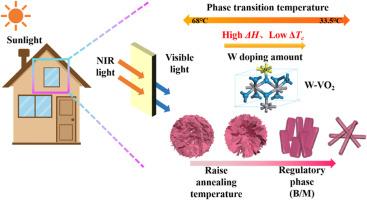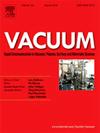退火调谐高相变潜热 W-VO2 纳米棒的 B/M 相变及相变特性研究
IF 3.8
2区 材料科学
Q2 MATERIALS SCIENCE, MULTIDISCIPLINARY
引用次数: 0
摘要
二氧化钒(VO2)可根据环境温度自发调节太阳热量,作为智能玻璃的候选材料具有巨大的应用潜力。然而,二氧化钒的Tc、ΔTc和ΔH不能同时协调,商业应用受到很大阻碍。我们在氩气环境下采用水热法制备了掺 W 的 VO2 粉末。对掺杂 W 的 VO2 的纳米花、纳米棒和其他形态进行了表征。测试结果表明,掺杂 W 能使 VO2 的 Tc 降低到 33.5 °C,ΔTc < 10 °C,并具有较高的ΔH(ΔH ≈ 36.98 J/g)。研究了掺 W VO2 的相变行为和形态变化机理。通过改变退火温度控制了B相和M相的转变,最终制备出具有良好相变特性的W-VO2(M)粉末,满足了智能玻璃材料的实际应用要求。本文章由计算机程序翻译,如有差异,请以英文原文为准。

Study of B/M phase transition and phase transition properties of annealing-tuned high phase transition latent heat of W-VO2 nanorods
Vanadium dioxide (VO2) can spontaneously regulate solar heat according to the ambient temperature, and has great application potential as a candidate for smart glass. However, its Tc, ΔTc and ΔH cannot be coordinated at the same time, and commercial use is greatly hindered. W-doped VO2 powders were prepared by the hydrothermal method under an argon atmosphere. Nanoflowers, nanorods, and other morphologies of W-doped VO2 were characterized. The test results showed that W doping could reduce the Tc of VO2 to 33.5 °C, ΔTc < 10 °C, and with high ΔH (ΔH ≈ 36.98 J/g). The phase transition behavior and morphology change mechanism of W-doped VO2 were investigated. The transformation of B and M phases was controlled by changing the annealing temperature, and W-VO2(M) powders with good phase transition properties were finally produced to meet the requirements of the practical application of smart glass materials.
求助全文
通过发布文献求助,成功后即可免费获取论文全文。
去求助
来源期刊

Vacuum
工程技术-材料科学:综合
CiteScore
6.80
自引率
17.50%
发文量
0
审稿时长
34 days
期刊介绍:
Vacuum is an international rapid publications journal with a focus on short communication. All papers are peer-reviewed, with the review process for short communication geared towards very fast turnaround times. The journal also published full research papers, thematic issues and selected papers from leading conferences.
A report in Vacuum should represent a major advance in an area that involves a controlled environment at pressures of one atmosphere or below.
The scope of the journal includes:
1. Vacuum; original developments in vacuum pumping and instrumentation, vacuum measurement, vacuum gas dynamics, gas-surface interactions, surface treatment for UHV applications and low outgassing, vacuum melting, sintering, and vacuum metrology. Technology and solutions for large-scale facilities (e.g., particle accelerators and fusion devices). New instrumentation ( e.g., detectors and electron microscopes).
2. Plasma science; advances in PVD, CVD, plasma-assisted CVD, ion sources, deposition processes and analysis.
3. Surface science; surface engineering, surface chemistry, surface analysis, crystal growth, ion-surface interactions and etching, nanometer-scale processing, surface modification.
4. Materials science; novel functional or structural materials. Metals, ceramics, and polymers. Experiments, simulations, and modelling for understanding structure-property relationships. Thin films and coatings. Nanostructures and ion implantation.
 求助内容:
求助内容: 应助结果提醒方式:
应助结果提醒方式:


